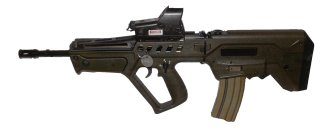TAR-21: What Makes Israel's Assault Rifle So Powerful?
Israel’s homegrown IWI Tavor TAR-21 assault rifle has been the standard-issue weapon of Israel’s infantry since 2009.
Israel’s homegrown IWI Tavor TAR-21 assault rifle has been the standard-issue weapon of Israel’s infantry since 2009.
That is the year the Tavor Assault Rifle-21st century took on the role the Israel Defense Forces formerly assigned to the American M16 and M4 rifles.
Designed by Israel Weapon Industries, the TAR-21 is equipped with a selective fire system that toggles between a semi-automatic mode and a full-automatic mode.
The rifle is gas-operated and shares similar modern mainstream features with a number of counterparts. Israel has exported the TAR-21 to more than 30 countries. It is used by law enforcement officers, government bodies, and militaries. The rifle’s efficiency and stellar track record have made it a staple in the IDF’s infantry.
Following the 1982 war with Lebanon, the IDF recognized the challenges urban warfare and close-quarter combat presented to its soldiers. The IDF needed a more reliable, durable, and maintenance-friendly weapon for its infantry. Ten years later, the IDF took serious action to design a more advanced automatic weapon when it launched the Tavor project in 1994. The IDF accepted the Tavor-21 in 2004, after two years of tests.
Versatility and Ease of Use
The Tar-21’s bullpup layout enables the rifle to be compact when necessary, without removing the capability of a long barrel. The bullpup design is also used to maximize soldiers’ effectiveness when turning corners in urban warfare, since it minimizes the soldiers' silhouette. The basic configurations for the rifle include its compact version, called the CTAR-21, and the micro rifle, or MTAR-21. The only differences between these configurations are in barrel length and accessories. The rifle’s long-stroke gas piston system features a piston that travels the same distance as the bolt carrier, simplifying the weapon and making it easier to maintain.
Additional useful characteristics of the TAR-21 are its ambidexterity and modularity. The rifle’s ejection ports are located on either side of the weapon, and both the right- and left-side ejections can be selected by installing the bolt with the ejector mounted on either side. This allows right-handed and left-handed soldiers to carry the rifle with equal ease.
The TAR-21 shares features with the American-made M-16 rifle, including a rotating bolt and a STANAG or NATO magazine. Each magazine that the TAR-21 fires is curved and features a double-column approach, similar to the M-16. The rifle’s fire-mode selector switch sits above the pistol grip.
Israel is unlikely to replace the TAR-21 rifle anytime soon. In 2021, the weapons division of Israel’s Ground Forces Command declared itself “very satisfied by its capabilities,” and said that “the rifle performs very well and has proven itself.”
Since its inception in the early 2000s, the TAR-21 has circulated widely. Its purchasers include Georgia, India, Portugal, and Thailand. In 2019, soldiers of the Royal Thai King’s Guard were seen carrying a gold-painted version of the Tavor TAR-21. Additional countries could make the Israeli-made rifle their infantry’s standard-issue weapon in the near future.
Maya Carlin is an analyst with the Center for Security Policy and a former Anna Sobol Levy Fellow at IDC Herzliya in Israel.
Image Credit: Creative Commons.

